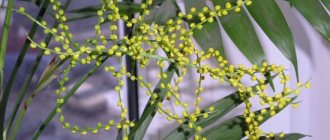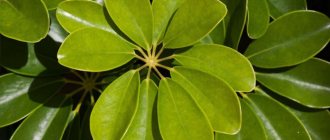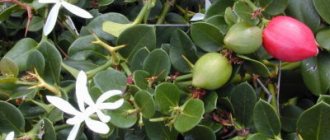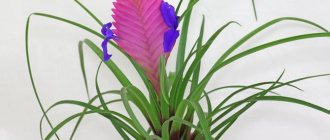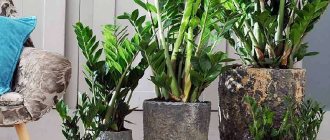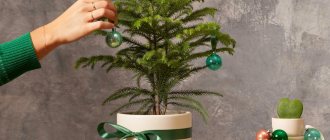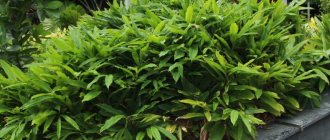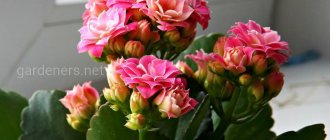Schefflera: care at home
Flower growers prefer the plant due to its beautiful, showy leaves that look like a human palm. The leaf blades are located at one point and resemble umbrellas. In the West, the crop is called the gnome umbrella or the umbrella tree. The culture branches like Benjamin's ficus. That is why bonsai lovers grow it as a home solitaire plant. Often trees of various shapes are formed from it. The culture has a small stem thickness, so it is planted several units in one pot. The stems are tied together to form a common trunk, which is intertwined. If it is a single tree, then it needs support due to its very thin stem.
Schefflera, home care:
- Schefflera is easy to grow indoors because it is unpretentious. Contains substances that, upon contact with the mucous membrane, may cause an allergic reaction or irritation.
- Therefore, pruning and watering should be done with gloves. Flowers prefer light; during the cold season, the shefflera is placed on the windowsill, which is located on the south side of the room. However, in the summer it is necessary to remove it, protecting it from ultraviolet radiation. Usually it is located near the window, in the southern part of the room.
- The culture grows well on the western or eastern side. Please note that in a room where there is little light, the culture does not feel well. If the apartment faces a shady side, you should choose varieties with dark green foliage. Varieties that are distinguished by variegated and bright leaves love light. It loves humidity, so it adapts well to the conditions in the house. It is necessary to constantly spray the settled water. It is necessary to maintain the temperature within 23-26 degrees.
- Watering should be constant, but it is impossible to fill the shefflera. It is necessary to use settled water to prevent the soil lump from drying out. In winter, the amount of watering is reduced. Do not allow the water to stagnate. As a result, rotting may occur and the crop will quickly disappear.
Umbrellas
Popular types of cheflera
The genus of this plant has more than 200 varieties. Of course, not all of them have settled into home pots. Only a few species are cultivated and attract gardeners.
Radifolia
Due to the unusual shape of the leaf plate, this sheflera is called star-leaved. Up to 16 leaves can diverge from the dark red petiole, slightly blunt at the end.
The length of the leaves of this species reaches 15 cm, width - 5 cm. Flower growers love this variety for its rapid growth.
Tree-like
Some types of sheflera grow up to 2 m in height
Interestingly, in nature, the tree-like sheflera is a liana, the length of which sometimes reaches 40 m. At home, it grows into a compact tree with bright leaves. The emerald surface often contains light inclusions. The indoor plant grows up to 2 m.
Eight leaf
The eight-leaved shefflera is easy to recognize: its rounded leaves are covered with shiny skin and change color as they grow. Young leaves are olive, becoming dark green over time.
Palmate
People call this sheflera “seven fingers”. The plant is distinguished by thin and soft leaves, which can be divided into 3–9 parts. The leaflets are oval in shape with slightly jagged edges.
Janine
The “Janine” variety is distinguished by its variegated foliage.
This species can easily tolerate a lack of light. Therefore, if there are no conditions in the apartment for growing sun-loving tropical flowers, you should choose a plant of this variety.
Bianca
The decorative variety "Bianca" is notable for its unusual shape and color of leaves. The short leaves have jagged edges and a light edge. The base of the leaf also contains white spots.
Schefflera flower: home care, pruning
Needs pruning, thanks to this it becomes much more magnificent. As mentioned above, often several seedlings are transferred to a pot so that they intertwine with shoots, thickening the stem. The crop takes on the shape of a tree thanks to regular pruning.
Schefflera flower, home care, pruning:
- However, if pruning is not done according to the rules, it can cause harm and cause the death of the crop. Falling leaves indicate improper care. However, you shouldn’t be upset; perhaps the flower can be saved.
- Perform low pruning, almost to the very root. This may work if the root system is healthy. The stump is watered and covered with damp moss so that the upper part of the cut does not dry out. If the manipulation is performed correctly, you will soon see young shoots.
Bonsai
Types and varieties
Among the numerous species of Schefflera, the following are cultivated in indoor floriculture:
- Radifolia. The trunk is erect, strong, grayish-brown, grows up to 80 cm. The petioles are brownish-reddish; the leaves are green and can have up to 16 lobes. On its basis, the “Compacta” variety was developed with variegated leaves and sizes more suitable for home conditions.
- Tree-like, sometimes called "Apricola" (schefflera arboricola). A compact plant, shaped like a branched tree. The leaves are large, up to 20 cm in length, bright green. Variegated varieties have been developed, for example, Janine: its leaves are creamy, with chaotic dark green spots.
- Sheflera is the most elegant. Compact, up to 50 cm, plant with serrated leaves, sometimes decorated with a cream edging.
Based on natural species (mainly Schefflera variegated), varieties designed specifically for indoor floriculture have been bred. The most popular among them are:
- Scheffler Melanie. The leaves are medium-sized, golden in color, sometimes with green splashes.
- Schefflera Gold Capella. The leaves are glossy, fleshy, golden-olive in color, sometimes green at the edges. To maintain variegation, it needs bright, diffused light all year round.
- Schefflera Nora. It is distinguished by its original shape of dark green leaves: the lobes are long, narrow, with large, unequal teeth. A yellow edging stands out along the edges; the vein is lighter in color. Unpretentious, densely leafy and graceful variety.
- Schefflera Bianca. The shape of the leaves is similar to the previous variety, but they are shorter, with a white edge along the edge.
- Scheffler Louisiana. An elegant plant with leathery, shiny, bright green leaves with yellow or white speckles. The central vein is clearly visible. The variety is undemanding to living conditions.
Schefflera flower: winter care
Winter for shefleras is a period of rest and peace. It does not grow, does not produce new, young shoots.
Schefflera flower, winter care:
- In winter, you need to place the crop on the windowsill, in a bright place, at a temperature of 16 degrees.
- Watering is carried out once a week in winter.
- In the cold season, the temperature can be reduced to 18 degrees. The lowest limit that a plant can withstand is +12 degrees.
- The culture is not suitable for a winter garden or growing on a balcony. It should be protected from drafts and not placed near heating devices.
- In winter, if the crop is located near heating radiators, it must be sprayed regularly. Do not apply too much moisture to the root; it is better to do this with a sprayer. Allow the flower to feed through the leaves and stems rather than the roots. If the crop grows slowly and practically does not produce new shoots and leaves, this indicates a small pot.
- If the shefflera has not been replanted for a long period of time, be sure to transfer it to a larger pot in the spring. The plant is unpretentious, however, like any crop, it can be overcome by pests.
Eight leaf
Sheflera variegated. Variety of types of shefflera, 19 photos
The Schefflera plant is named after the German botanist Scheffler and is part of the Araliaceae family. Ginseng and ivy are also members of this family. Schefflera is a plant of the tropics and subtropics; in its homeland it is considered quite aggressive, displacing other crops. But the shefflera flower is very beautiful.
Here it has become a popular houseplant and is recognizable by its palmately compound leaves.
There can be from 5 to 18.
The leaf blade itself, depending on the type, can be narrow, rounded, jagged and wavy.
There is a wide variety of forms that are united under one name. There are several hundred species of it.
Types of cheflera
Schefflera Mix, that is, a mixture, is popular among beginning gardeners.
These are the most unpretentious varieties that are readily purchased.
For example, trees with gracefully intertwined trunks are Schefflera Compacta intertwined. Small-sized indoor plants, such as Schefflera Moondrop (Moondrop), remain favorites.
Schefflera arborescens, or woody
Schefflera arboreal in its homeland in Taiwan grows as an evergreen bush, up to 4 meters high. The leaves have from 7 to 9 plates. It is distinguished by the unpretentiousness and beauty of the variegated varieties of this species.
Woody Schefflera is also grown as a bonsai.
A miniature form like Caster looks good. If you have little space, but want to have this particular plant, then the Caster variety is your option. Small in size, 20-30 cm, it will decorate any interior: home or office.
One of the low-growing varieties is also Schefflera Melanie, a graceful variety with small leaves. It does not grow above half a meter.
And Gold Capella, one of the tree-like varieties, is distinguished by its leaves: on a dark green background there are bright golden strokes and spots.
Based on Schefflera woody, the Schefflera Charlotte variety was also recently developed with bright green leaves with white spots, leathery and shiny - a favorite of landscape designers.
Schefflera radiata
Schefflera radiata (or star-leaved) grows in its homeland in Australia as an epiphyte, that is, on trees. It has many aerial roots. In nature, its height is about 12 meters, and the leaf plate can reach 60 cm.
As an indoor plant, the plant grows 60-80 cm, then growth slows down. Radiant varieties are very decorative. Its leaves can be olive, light green in color, and have a finely toothed shape.
Schefflera eight-leaved
Schefflera octophyllum is known in Asian countries. There it grows like a bush or tree, its height is 2-16 meters. The leaves, according to the name, are crowned with a rosette of 8 plates. They are very beautiful, leathery and glossy.
They come in different shapes, depending on the variety: from oval to ellipse, 7-15 cm in length. Sometimes it is called eight-leaved.
Schefflera the most graceful
Grows in Australia and New Zealand. In nature it reaches 2 meters and is distinguished by its lush green mass with a small number of stems. In indoor conditions it is much smaller than other species; in adulthood it has a height of 50 cm.
This elegant species has interestingly shaped leaves: elongated to oval, serrated along the edges. Some varieties have beige edging.
Scheffler Veitch
Known for the reddish hue of its leaves when young. Over time, the leaf changes its color to normal. The leaf shape of this species is very unusual: a wavy leaf plate, jagged along the edge, a real decoration for a home or office.
Veitcha is a rather rare species, and due to its decorative nature it does not linger in flower shops.
Schefflera palmata
Schefflera digitata in its homeland, New Zealand, grows more than 3 meters in height, as a houseplant - 60-70 cm. The leaves are dissected, like all types of schefflera. Depending on the variety, it has from 7 to 14 leaf blades, slightly wavy.
The edge has an interesting shape: from feathery - in youth, to jagged - in adulthood. The most shade-tolerant of them, Schefflera Amate, belongs to this species.
Schefflera business
Its homeland is the forests of Western China. The height in nature is 2-3 meters. The leaves are very beautiful, the plate resembles an oak leaf. As a houseplant - quite squat, about half a meter. Prefers a little shade, otherwise this species is grown in the same way as others.
Schefflera flower: home care, replanting
As for replanting, young plants need it annually.
Schefflera flower, home care, replanting:
- Every spring it is necessary to replant. Adult sprouts are transplanted as needed.
- This should not be done every year, but once every few years. The root system grows and may not have enough space in a cramped pot.
- The container for transplantation is selected several times larger than the previous one. Be sure to take care of drainage.
- It is worth using slightly acidic, light soil. A mixture consisting of peat, sand, humus in a ratio of 1:1:3 is selected. Sand and turf soil are often used in a ratio of 1:2.
Culture
How to transplant a shefflera. Tip 1: How to transplant a sheflera
Schefflera leaves are a unique and truly charming presentation. They simultaneously resemble a dill umbrella, a tropical butterfly, and an unprecedented peacock tail. Growing this plant at home is not that difficult; you just need to follow the care instructions. If you plan to transplant your green beauty, you also need to do this correctly.
- – “multifunctional” soil,
- - flowerpot,
- – water,
- – drainage.
Instructions
1. First, find out whether your cheflera needs a transplant. Shefflers replant young plants every year because they grow vigorously and quickly fill a small pot with their roots. Older plants, more closely formed, need to be replanted once every two to three years. If you still have any doubts, you can do the following: remove the shefflera from the pot and examine its root system. If you see that the roots are encircling the bottom and there is very little soil left, it’s time to replant. If there are only a few roots and the earthen lump is still loose, you can wait a little longer. 2. Start replanting by preparing the pot. Young sheflera plants are replanted with partial replacement of the earthen clod. Pour drainage and fresh soil into a larger pot so that after planting the plant, its roots do not protrude beyond the new pot. Carefully remove the shefflera from its dilapidated home, remove excess soil and replant. To ensure that the root system has a chance to grow in a new pot, plant the plant on a wide layer of soil, and not on drainage, lightly sprinkled with soil. After replanting, the plant must be pressed tightly so that no voids form in the pot, and the roots can adhere more closely to the ground and be watered generously. 3. Heavily large cheflers are replanted without replacing the soil ball. Easily remove the plant from the pot and transfer it to another, slightly larger one. Do not forget that there should be drainage in the pot in any case. Occasionally, if for some reason replacing the soil ball is unthinkable, it is appropriate to replace the top layer of soil. Carefully, so as not to damage the roots, remove the top layer of soil in the pot by about 10 cm and pour new fertile soil on top. Often, the top layer of soil in a pot cakes, making it difficult for moisture and air to circulate to the roots. Replacing this layer with a more loose and fertile one has a significant healing effect on the shefflera.
The plant is unpretentious and is often placed in office premises (a beautiful and neat tree or bush is in harmony with the work environment). But, nevertheless, it is important to know the basic rules of care and some features of the plant.
Watering
Like any tropical plant, it loves moderate watering as the top layer of soil dries out. In summer, the plant is watered once every 2-4 days, depending on the temperature and humidity of the environment, in winter - once every 10-12 days. Schefflera requires periodic spraying with soft, slightly cool water. You can place the container with the plant in a small tray with water or moistened moss. The plant will absorb the required amount of moisture through the drainage hole and leaves.
Top dressing
The plant needs a complex of vitamins and minerals, which will give it the opportunity to grow and develop. Feeding with any complex mineral fertilizer for decorative deciduous plants will help with this. Feeding is carried out through watering or spraying the leaves. In summer 2 times a month, in winter – 1 time.
Trimming
If you want to get a spherical version of the plant, you need to cut off the top at a height of 4-5 internodes with a sharp knife. The plant will gradually acquire the desired shape. To avoid causing harm, pruning is carried out in stages. If you want to grow a neat tree, do the same pruning of side shoots and leaves that stand out too much.
Transfer
If you purchased a young plant, it should be replanted once a year according to the method specified in paragraph 2. An adult plant is replanted every few years using the transshipment method if the soil is depleted and the bush has grown greatly. It is also necessary to replant the shefflera if the roots become visible through the drainage hole. This means the potty is too small for her.
Schefflera flower: care, propagation at home
There are several ways to propagate sheflera. The crop can be grown by sowing seeds, cuttings, or air layering. Seeds can be purchased at garden centers. Sowing is carried out in January or February, that is, in the cold season. It is necessary to sow in a mixture of sand and peat, which are mixed in equal proportions. The seeds are kept in a weak solution of potassium permanganate to get rid of pathogenic microflora. After this, Zircon or Epin is administered.
Schefflera flower, care, propagation at home:
- These are growth stimulants that improve rooting and stimulate rapid growth. After sowing, it is necessary to moisten the soil with a sprayer and put it in a dark place at a temperature of 24 degrees.
- Be sure to cover the pot with glass or film to maintain a high level of humidity inside. Ventilate the soil and moisten it from time to time.
- Do not forget to provide air flow, because the surface may become moldy and pathogenic microorganisms will begin to develop. After you get two leaves, you need to transplant the seedlings into small pots.
Big leaves
How to defrost a shefflera. The most famous methods.
Today, many experienced gardeners know everything about how to propagate this unpretentious and simple plant. But for beginners in this business, our recommendations will be very helpful. So, the main methods of propagating cheflera at home are as follows:
- by propagation by cuttings;
- through seed germination;
- by propagation by layering.
In addition, it is important to remember that without knowledge of the specifics of caring for a cheflera flower, none of these methods will fully guarantee positive results.
The simplest of them is propagation of cheflera by cuttings . To do this, we recommend using semi-lignified cuttings, which are cut in the spring. Next, root the cuttings in water or take a substrate, for example, add sand (necessarily coarse-grained) to regular soil, follow the proportions 1:1. Before this, the places where the cuttings are cut need to be treated with a special root formation stimulator to make rooting easier.
If you use water for rooting, when the roots appear and develop (fastest in Schefflera, a solid green color; in variegated ones, after 4 weeks), plant the cutting itself in the ground, cover it with a bag, after making a hole for air to enter. But at the same time, do not forget to remove the bag every day 1-2 times, the plant should be ventilated for 20-30 minutes.
When rooting in the substrate, the bag should be put on immediately and ventilated according to the same scheme. Do not over-moisten the substrate; it should be kept slightly moist.
The second method is propagation of sheflera through seed germination . Unfortunately, cheflera cannot obtain the fruits of their seeds at home. Therefore, purchased seeds are planted in winter, mainly January-February, but also in March. The soil must be loose, air and moisture permeable. You can use two types of soil mixture that are perfect. We recommend peat with sand or a handful of sand and a liter of soil. The seeds go deeper into the ground about half a centimeter. Next, water, cover with film and place in a place with an acceptable temperature of 22-25 degrees Celsius. It is enough to ventilate the flower once a day, while removing the film. The pot where the seeds were sown must have drainage and a hole to drain excess water. When seedlings appear, the plant will require a brighter habitat. Create an air temperature within 15-17 degrees Celsius. When summer comes, do not forget to spray your baby cheflers with warm, not cold, water.
by layering will be interesting , provided that there is a large version of this flower. When spring comes, cut the trunk of the plant. It is important to wrap the cut area with a layer of green moss, and then cover it with a layer of film. The moss must be wet. After a month, maybe a little later, roots appear and then the stem can be cut off at the bottom of the new roots and planted in soil made from a 1:1 mixture of peat and sand. When the sheflera has new leaves, feel free to replant it in its usual place.
Schefflera flower: propagation by leaf
The easiest way to propagate is by cuttings.
Schefflera flower, leaf propagation:
- For this, lignified cuttings and upper parts of the stem are used. For rooting, planting is carried out in a mixture of peat and sand.
- The place where the cutting is cut is treated with growth and root stimulants, and the container is covered with film.
- The optimal temperature for growth is +22 degrees. Don't forget about ventilation.
Culture
Schefflera
A plant such as Schefflera or Schefflera belongs to the family called Araliaceae. In the wild, it can be found in the tropics in any part of the world. And most often it is found in Australia, China, the Pacific Islands and Japan. Wild-growing shefflera is not very large trees or bushes.
Schefflera flower: signs
Schefflera is a plant that not all indoor plant lovers want to grow at home. Many believe that it is an energy vampire, interfering with the positive aura in the house. But esotericists and knowledgeable people claim that the flower only absorbs negativity, cleansing the house. It is recommended to install pots with plants in the bedroom. During sleep, a person's thoughts will be cleared and negativity will be absorbed. This will allow you to have a good rest and sleep. It is recommended to install the pot with the culture in the room of a schoolchild or student. This will improve your memory, and the learning process will be much faster and more successful.
Schefflera flower, signs:
- Sheflera can warn its owners about impending misfortune or unpleasant events. If the leaves curl, this indicates deception of someone close to you.
- If the leaves suddenly darken, the flower cannot cope with the negativity that is present in the house. Talk to your loved ones, try to resolve all problems without scandals. Don’t hide important information, don’t try to solve problems yourself, this will lead you to a dead end.
- If the plant has stopped producing new shoots and green leaves, financial stagnation or depression awaits you.
- It is a good sign if the crop grows quickly and produces a lush crown and a large number of green leaves. Esotericists are sure that this promises an increase in the family, perhaps the couple will have a child. They recommend installing in offices, caring for, fertilizing and watering. If the crop pleases with a large number of green leaves, this promises success and financial well-being. In the reception area of an enterprise, the plant is capable of absorbing negativity and protecting the office from ill-wishers.
Bonsai
Schefflera reproduction. How can it reproduce by leaf?
Propagating Schefflera by leaf is not the easiest way, since the leaf does not always produce roots.
Let's look at the stages of propagation by leaf:
- We select a medium-sized leaf and carefully tear it off from the main plant. It is important that the growth zone (the growth between the base of the leaf and the stem of the plant) separates along with the leaf.
- Next, prepare a stimulating solution (by analogy with cuttings) and drop the required number of leaves into it; it is better if there are more than two of them, since not all of them will be able to take root; a small supply is needed. Set aside the water for the solution.
The stimulating solution requires the correct dosage and settled water
- Place the prepared dishes with the solution and leaves in a warm place, cover with film and glass.
We prepare the substrate. It should be warmed up and can be placed together with the leaves.
- When the leaves form roots, they need to be planted in the soil, creating a greenhouse. There is no need to ventilate at first; the leaf must get used to the conditions. It is worth monitoring soil moisture.
After the operations, when Sheflera grows up, she is transplanted. Leaf propagation is not common. However, we talked about the correct propagation of violets by leaf at home.
Soil for sheflera at home
An important step is the correct choice of soil. The culture prefers light, well-drained soils that allow air to pass through well.
Soil for sheflera at home:
- Among them, it is worth highlighting special soil for sheflera, or preparing it yourself.
- Mix turf, humus, leaf soil and sand. There are substrates that can be purchased at garden centers.
- They are designed for growing this plant.
Bush
What kind of soil is needed for shefflera? Schefflera Bianca
This variety differs from the others in having shorter leaves, which reach up to 8 centimeters in length. Each leaf blade has a white edge and beige patches at the base. Due to the contrast of dark and light shades, the decorative notches decorating the edges of the leaves become almost invisible.
Schefflera arboricola (schefflera arboricola) is a flowering shrub, the birthplace of which is considered to be China. In nature, it has a straight trunk and reaches a height of up to 4 meters. The plant has complex, palmate, large leaf blades of a light green hue.
Schefflera Caster - the plant has decorative dimensions, so it will be an ideal option for growing in an apartment. It reaches a height of up to 120 centimeters and has dark green, leathery, shiny leaf plates of medium size.
Schefflera radiata (schefflera starifolia) is the most common type of plant. In nature, shefflera reaches a height of 15 meters and can have one or two trunks. When growing a tree at home, it will grow up to 2.5 meters in height. It has dark green, leathery, shiny, large leaf blades with jagged ends. Schefflera blooms with small red inflorescences.
Schefflera leaves are turning yellow, what should I do?
The crop needs feeding, every week, starting in spring. It is worth alternating fertilizing, one week adding nitrogen and complex preparations for indoor crops, and the next time adding organic ones. In winter, the flower does not need fertilizer. During this period, the amount of moisture is reduced and fertilizers are not applied. It is recommended to reduce the temperature to give the culture rest.
Each owner of a houseplant independently decides when to fertilize and prune. Experts recommend trimming the top. After it, side leaves and branches will begin to grow. The plant will become more lush and voluminous. Leaves cut from the top can be placed in water and rooted. This will allow you to grow additional seedlings. By the condition of the leaves you can determine what the flower is missing.
Schefflera leaves turn yellow, what to do:
- If they darken at the tips, the crop does not have enough fertilizer.
- If the leaves dry out at the tips, it means the plant does not have enough moisture.
- If darkening is observed at the tips, stop watering. This indicates an excess of moisture.
- Yellowing of the crown indicates a deficiency of minerals and stagnation of moisture.
Fruit
Care errors and their elimination
Problems with cheflera arise more often due to incorrect content. The plant reacts painfully to stagnation of moisture in the soil, lack of lighting, dry air, and temperature changes.
Common problems and their solutions:
Problem
Causes
Solution
High or low temperature, waterlogging
Avoid sudden temperature changes, water moderately, avoid stagnation of liquid
Fading of leaf plates, light spots on the surface
Do not place the flowerpot in direct sun or in the shade; diffused light is better for the plant.
Drying leaf tips
Dry air, lack of moisture in the soil
Schefflera diseases and their treatment
Below we will consider the most common ailments that affect the chef:
- Shchitovka
- Spider mite
- Thrips
Schefflera diseases and their treatment:
- Please note that such a plant must be taken to a separate room and placed away from other plants so that they do not become infected.
- It is necessary to dilute laundry soap in water and apply it to the roots and stems using a spray bottle. Using a cloth soaked in soapy water, you need to remove scale insects and spider mites.
- If this does not help and the plant is completely covered with pests, it is necessary to spray with Karbofos. Repeated treatment should be carried out after 2-3 weeks.
- With excess moisture, it is possible not only for the leaves to darken at the ends, but also for the roots to rot. In this case, replanting with removal of the affected roots will help. It is necessary to wash the roots under running water and cut off the damaged areas with sharp scissors.
The soil that was used to plant sheflera must be thrown away. It cannot be reused; it contains mold spores and pathogenic microorganisms that grow as the roots rot. A new substrate must be used. If it is not there, you can calcine the existing soil in the oven for 2 hours. You can treat the soil with karbofos.
Scheffler
Landing
Shefflera seeds are planted in the second half of winter: from mid-January to the end of February. Before planting, seeds are soaked in a stimulant (according to the instructions), for example, Epine or Zircon, to speed up germination.
The seeds are planted in disinfected soil, consisting of turf and leaf soil with the addition of sand, all components are taken in equal parts. The second option for planting mixture is sand mixed with peat in a one-to-one concentration.
The seeds are placed at a depth of five to six centimeters. The distance between adjacent ones should be twice their size.
After planting, the soil is periodically watered, not allowing it to dry out, and the room temperature is maintained in the range from +20ºC to +25ºC.
The pot can be covered with plastic wrap to create a greenhouse effect; in this case, the plant needs regular ventilation.
The seedlings are transplanted into pots when the first three leaves appear on them. It is very important to keep Schefflera seedlings at a temperature of +19 ºC for the first three months after transplantation.
Location and lighting
Lighting is very important for shefflera, so the best location for it is on the windowsill of the eastern, western and northern windows. Schefflera
should be in the brightest place in the room.
Please note that variegated Scheffler varieties may lose the expression of their color due to lack of light, so even northern windows are not sufficiently lit for them.
The location on southern windows should be treated with caution, as it can be hot for the plant on them, and exposure to sunlight can lead to burns of the leaves.
If the room's windows face south, the shefflera will have enough lighting on a table standing close to the window.
With a lack of lighting, Schefflera stops its development and sometimes even dies, so in low natural light, use fluorescent lamps.
Pot size
The size of the pots is selected depending on the age of the plant. Seedlings are planted in small containers, which can be plastic cups. When the root system of the plant takes up all the space, the Schefflera is transplanted into a pot with a diameter of 9 centimeters, and by autumn - 12 centimeters in diameter. For subsequent transplants, the size of the pot should be 3-5 centimeters larger than the previous one.
The soil
The soil for planting shefflera may vary slightly in composition, but must be nutritious, light and well-permeable to air.
An adult plant can grow in the same soil in which the seeds were planted: a peat-sand mixture or a mixture of sand with turf and leaf soil.
For an adult shefflera, you can prepare a new mixture: 2 parts turf soil, 1 part leaf soil, 1 part river sand and 1 part humus.
If you do not want to prepare the soil yourself, the flower shop sells a ready-made mixture; soil for ficus plants is best suited for scheffler.
Transfer
The frequency of transplanting Scheffler depends on the plant: grown from a Scheffler seed, it is transplanted in the first year of its life, about six months after planting. Small developing plants are replanted every two years, and large ones - no more than once every three years, and better - every five years.
Young plants must be replanted more often due to the development of the root system, which quickly takes up the entire space of the pot.
The new pot should not contain voids, so the soil is pressed tightly so that the roots fit tightly to the ground.
When transplanting, expanded clay drainage should form at the bottom of the pot.
When the plant is transplanted, it must be watered well.
Large plants are replanted while maintaining the formed soil ball. For them, only the top layer of soil changes; for this, the top ten-centimeter layer of soil is removed and a new one is brought in its place.
The safest way to transplant branched schefflera is the transshipment method.
Fertilizers and fertilizing
Shefflera is fed only with liquid fertilizers. Fertilizers should be for indoor plants, and the frequency of feeding depends on the time of year. In the period from October to March, shefflera is fertilized once every two months, and the rest of the time - every three weeks.
The concentration of fertilizer recommended on the package is not always suitable for Schefflera, so if the fertilizer is not familiar to you, prepare a solution of a weaker concentration. It is much safer to make the fertilizer concentration 5 times weaker, but apply it twice as often.
A fairly popular method of fertilizing Scheffler is weekly during the summer with a mixture 8 times weaker than recommended.
Dry fertilizing is undesirable for Scheffler, and fertilizing with sticks can lead to an overdose.
Watering
Growing schefflera will be successful if only the plant is provided with proper watering.
The soil should always be slightly moist, and watering the plant should be moderate.
If we talk about extremes, sheffler tolerates dryness better than waterlogging. If the soil contains a lot of moisture, the plant's leaves will begin to turn black.
In warm weather, in addition to watering, the plants are additionally sprayed with soft water.
In winter, Schefflera does not develop as quickly as in summer, so watering is reduced. The difference in temperatures is compensated by spraying, that is, if the room temperature is the same in both winter and summer, then watering is reduced, and spraying remains the same.
Temperature
The temperature of the room in which shefflers develop best ranges from +18 ºC to +23 ºC. At the same time, shefflers are not picky and develop well under normal conditions, the main thing is to carry out timely spraying and maintain a good microclimate.
In winter, try to keep the plant away from heating devices, as severe overheating causes the leaves to fall off. Try to avoid sudden changes in temperature.
Humidity
Schefflera prefers high humidity, so she feels very comfortable in a room with a lot of plants.
Spraying has become a very popular way to moisten shefflera. This procedure is especially indispensable in hot, dry weather. Use exceptionally soft water for spraying, preferably filtered, so that no white stains remain on the leaves.
Leaves should be regularly wiped from dust with a damp cloth.
Air humidity can be increased by placing the pot on a layer of wet expanded clay.
Trimming
To give the plant a tree-like shape, pruning is carried out. To get a lush bush, several flowers must sit in one pot.
Pruning is not carried out for plants that shed leaves, since the reason for this lies in the roots of the plant and pruning will not help here.
Sheflera care: reviews
Below you can read reviews from flower growers who grow sheflera.
Sheflera care, reviews:
Svetlana. I have many flowers, most of which are violets. Recently I gave it to a chef for his name day. I don’t like it when people give fresh flowers, but I couldn’t refuse such a gift. The plant is very lush, with a lot of leaves. I really liked it, I take care of it, like all the crops on the windowsill. Recently the plant began to wilt. After Googling, I realized that this is due to the large amount of light, because almost all of my plants are on the windowsill on the south side. She moved the chef to a shady place and fed her with complex preparations for home crops. The plant came to life and began to delight with new leaves. I hope it will be fully restored soon.
Alexandra. I don’t like house flowers, but I brought a small cutting from work. I really liked the plant that was on the windowsill in the office. I learned from the secretary that the plant repels negativity, so I decided to get one for myself. A bush grew from a small shoot that I cut from the top of the mother tree. I don’t fertilize with anything, I just water. I placed it on the windowsill on the west side. There is not much light here, but it is enough for the sheflera. The culture does not tolerate ultraviolet radiation.
Veronica . I love homemade flowers, I try to buy new ones that I see at the garden center. Now it's not cheap. When I was visiting, I noticed a cute plant and asked the hostess for a shoot. It turned out that this is a cheflera, it looks very beautiful, reminiscent of a bonsai tree. The stems are thin, so I purchased additional support. I learned on the Internet that plants can be woven together with stems to form a thick trunk. I want a tree with a thick stem to grow. I hope everything works out for me. The tree is unpretentious; in winter I often spray it, but I water it only once every 7 days. In winter, plants need rest.
Bush
We advise you to read the articles on our website:
- Weeds in the garden: varieties, names, control methods
- 10 useful tips for gardeners and gardeners for a better harvest
- Green manure mustard - when to sow and dig
- A vegetable garden for the lazy person that doesn't dig
You need to feed with universal fertilizers, which are often used for other domestic crops. Typically, fertilizing is carried out once or twice a month, in the spring and summer, when a large number of young shoots are growing. It is recommended to feed the tree after the first leaves appear.
How to treat sheflera. Schefflera - diseases
Sheflera is a guest from Southeast Asia. We only recently learned about it, but we have already dubbed it the “Umbrella Tree”. If you provide the plant with proper care, it grows to impressive sizes (2-4 meters in height and up to 1.5 meters in width). This plant is able to withstand significant drops in room temperature and lack of lighting, but, like many others, it is often susceptible to attacks by diseases and pests. In this material, experienced flower growers will be happy to share tips with our readers.
Problems and solutions
Treatment for many diseases of Schefflera is fungicidal and insecticidal treatment. But no less problems arise due to improper care of this plant. Often the reason why the cheflera withers and gets sick is excessive room humidity and excessive watering. These two factors contribute to root rotting; in this case, the plant must be replanted, simultaneously removing the affected parts of the root system. No less harm can be caused to sheflera by harmful insects; the worst enemies of this plant are spider mites, scale insects and thrips. Many, listening to the advice of “experienced” people, limit themselves to treating a plant infected with mites with a soap solution. Great plan - water treatments for insects! In fact, everything is somewhat more complicated; these insects are resistant even to most insecticides, so it is very difficult to remove them, especially if you miss the moment. Schefflera leaves darken and fall off when the plant has a “cold”, which is due to drafts and excess humidity in the room. Enough about the horrors, let's figure out how to properly care for a plant and what to do if it is attacked by insects or gets sick.
Schefflera pruning. Purpose
Many novice gardeners often neglect pruning plants, but in vain. This procedure not only makes it possible to give the bush the desired shape, but also protects it from disease. Schefflera, despite its unpretentiousness, especially needs the timely removal of excess shoots.
Shefflera trimming can be of two types:
- direct formation of the crown - for greater splendor and density of the plant;
- removal of weak, yellowed, dried out, diseased branches.
In order for the plant to begin to branch, you need to cut off the top. Then you will get a lush tree with a dense crown. If you want to form a bush, you need to cut the trunk itself above the bud that has not yet awakened. In this case, the plant will begin to throw out branches throughout the trunk.
In addition, it is necessary to regularly pinch the bush to regulate the length of the lateral shoots.
It is important to choose the right time for such operations. During the dormant period, in winter, the plant does not need to be touched. This will not only not give the desired result, but may also negatively affect the health of the tree. It is best to wait until spring (March–April), when the plant wakes up and all processes are restored.
Pruning is not just a whim of a gardener who is passionate about his business. This is a necessary operation that must be performed regularly. It performs the following functions:
- allows you to give the plant the desired shape depending on the wishes of the owner;
- promotes the growth of young branches;
- makes it possible to obtain propagation material without harm to the tree itself;
- helps remove damaged or diseased shoots after hibernation.
It is important not to overdo it and not to cut off too much, otherwise, instead of being completely beneficial, the operation may cause harm to the plant. Too long shoots are usually cut off by one third. This is enough to give shape and achieve the desired result.
In addition, pruning a plant, in particular, schefflera, requires compliance with certain rules in order for the process to be the least painful and bring maximum benefit. There are several factors that go into these rules.
- Compliance with the timing of the operation. It is carried out in early spring before the growing season begins.
- The first pruning is carried out after the plant has grown and is more or less formed, strengthened, and accustomed to the conditions. For the first time, 3-4 internodes are cut off on a branch.
- Under no circumstances should you use scissors - only good quality and sharp pruning shears.
- The cuts must be treated with an antiseptic (activated carbon works well), but if the branches are thick, the cut area will need to be covered.
- An adult plant can be cut off at the root (if necessary) - it will not die, on the contrary, it will produce young shoots and grow back.
- To provoke the growth of side shoots to form a round crown, you need to cut the top of the plant into 6-7 internodes.
- To ensure even branching, you need to pinch the ends of the branches.
- After winter it is necessary to carry out sanitary pruning.
Schefflera crown formation. Pruning and rules for forming the Schefflera crown
Often the owners of this indoor flower fail to achieve a full crown. Such plants do not look very decorative. There are small tricks in caring for it that help to form beautiful and lush greenery.
The first and most important thing to remember: shefflera requires the formation of a crown, and read about the pruning rules below.
The second trick is to plant several sprouts in one pot. This planting is done quite often, which makes it possible to achieve high external decorativeness of the indoor flower and the required density. 2-3 plants in one pot look better than alone.
It is important to remember here that the sprouts must be identical in their development and height. This is a guarantee of harmonious and uniform growth of the shefflera. Before transplanting the sprouts, prepare a good soil mixture, and place the young plants close to each other.
Later, after the plant has rooted, they are twisted together:
- Double helix (two branches).
- Pigtail (three branches).
In addition, some varieties of this plant branch very poorly, and without human intervention it will not be possible to achieve a beautiful shrub or tree. But here you should also adhere to certain rules.
If after the intervention the shefflers turn yellow and their leaves begin to fall off, then most likely the formation of the crown did not proceed correctly.
Correct pruning takes place on an already well-rooted tree, which has a shoot with 4-5 internodes from the bottom. It is at this level that the crown is formed.
Carefully! May contain substances that irritate the skin. Wear gloves when handling and wash your hands thoroughly when finished.
After the cutting area has healed, young side shoots will soon appear. This is how the crown is formed in the shefflera.
Important! When the flower grows, individual shoots should be tied to bamboo supports or the tops of young shoots should be cut off so that the plant bushes more strongly.
Schefflera is losing leaves - what is the reason
Basically, the origins of this trouble are in excessive watering. Roots flooded with water rot and do not have time to transfer the necessary moisture upward, so the leaves wither. Schefflera also cannot absorb nutrients and minerals, hence the massive leaf drop.
So you need to be careful with watering, and in case of problems, dry the substrate and remove dead branches. Replanting it in a new pot can also help - if the flower is not too large. The pot must have holes in the bottom through which excess water drains!
Schefflera and its reproduction
There are two ways to reproduce a flower:
- propagation by upper cuttings: you need to cut off the upper parts of young shoots, place them in a moist substrate and wrap the cuttings in foil (along with the pot). After about 6 weeks, the cuttings will take root in the soil and the foil should be removed;
- propagation by air compresses is a longer method, but no less effective. In this case, a piece of bark is removed from the young shoot, the cut site is covered with damp peat soil or moss and wrapped in aluminum foil, preventing it from slipping. After a few months, roots will form at the site of the “wound”. The shoot must be cut off from the mother plant and transplanted into a separate pot.
Rooting Schefflera cuttings in water
At first glance, it is easiest to root sheflera in water.
It was in this way that I had previously propagated the plant a couple of times using root cuttings. All you have to do is place the plant in a transparent container with water and wait. Be sure to add charcoal or an activated tablet to avoid rotting. You can also add a little root. To root in this way, it is better to take a cutting that has just begun to become woody with several rosettes of leaves. This time it took about three weeks for the roots to appear in the water.
When the roots were 1-2 cm long, I planted the cutting in a pot next to the mother plant, because... I want to make a bush with three levels.

